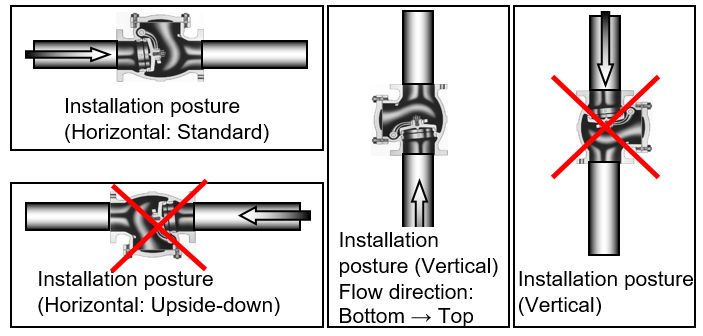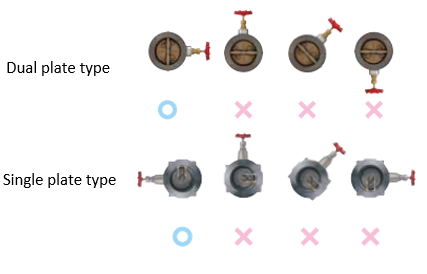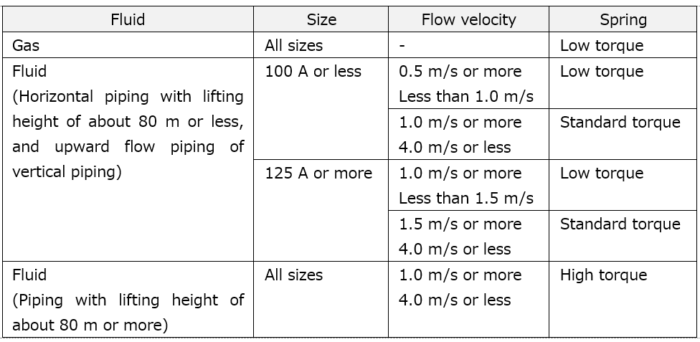Check Valves Questions
Installation posture
- Is it possible to use a swing type check valve in vertical piping.
-
It is possible to use a swing type check valve in horizontal piping and vertical piping.
However, when installing in vertical piping, make sure that the fluid flow direction in the piping is from the bottom to the top and that the arrow of the casted display on the valve body is from the bottom to the top.
- Is it possible to use a lift type check valve in vertical piping.
-
It is not possible to use a lift type check valve in vertical piping.
A lift type check valve can be used by installing it in horizontal piping only.
When installing the valve, be sure to install it with the cover facing the top.
- Is there any restrictions on the installation posture of a wafer type check valve.
-
A wafer type check valve has restrictions on the fluid flow direction and valve installation direction.
When installing the valve, pay attention to the following points and install it so that the direction of the arrow on the valve body matches the fluid flow direction.・ Although the valve can be used in vertical piping, make sure that the fluid flow direction in the piping is from the bottom to the top and that the arrow on the valve body is also from the bottom to the top.
・When connecting a dual plate type (two disc type) product to horizontal piping, install it so that the bypass valve is positioned in a horizontal position.
・In the case of a single plate type (one disc type) product, install it so that the pin is positioned in the upper position. If it is installed at an angle other than horizontal, the disc may not fully close due to the influence of gravity.
- Is it possible to use a vertical lift type check valve in horizontal piping?
-
A vertical lift type check valve cannot be used because the disc and seat may shift when closed.
Product information
- What are the selection criteria for standard, high torque spring, and low torque spring of wafer type check valves?
-
Please refer to the following criteria as a guide when selecting the standard torque spring, low torque spring or high torque spring for the spring to be attached to the disc of a wafer type check valve.

Use condition
- When is the bypass valve of a wafer type check valve used?
-
Normally, use the bypass valve of a wafer type check valve “fully closed”.
The bypass valve is opened in the following cases.
1. When draining water from the piping for maintenance, etc.
2. When priming water is required when starting the pump (bleeding the air in the piping)
- What flow rate (flow velocity) is required to keep the disc opening of a check valve above a certain level?
-
A rough guide for the average flow velocity in the pipe required to keep the disc at a constant opening is as follows for a swing type check valve.
“For water”: 1 – 3 m/s
“For gas”: About 30 – 50 m/s when the pressure is about 100 KPaG with normal temperature air
A check valve may cause chattering even if the flow velocity is too slow or too fast, shortening the service life of the valve.
We recommend to select the valve size so that an appropriate flow velocity can be obtained.
Piping condition
- When a pump is installed upstream of a check valve, what distance is required from the pump?
-
① Swing type, lift type, ball type check valves
Chattering may occur because of turbulence, eddy currents, or pulsation of the fluid.
Install the valve with a distance of at least six times the pipe nominal diameter.② Wafer type check valves (excluding stainless steel products)
As for pump discharge, the valve can be directly connected to the pump.③ Stainless steel wafer type check valves
Since the structure is different from wafer type check valves made of other materials, the valve cannot be used by connecting it directly to the pump.
As for pump discharge, ensure a straight pipe section that is at least twice the pipe nominal diameter (at least three times the bore diameter when the pump discharge has a tube expansion of two sizes or more).
Seat leakage
- Are there regulations for the seat leakage amounts of bronze/brass check valves?
-
When taking a 10K bronze/brass valve as an example, based on JIS B 2003, the seat leakage is measured by applying water pressure at 1.54 MPa (1.1 times) and then reducing the pressure to 0.51 MPa, which is 1/3 of the initial pressure.
Judgment of test result: 0.1 (mm3/sec) x Valve nominal diameter (mm)
For example, in the case of 50A, the test time is 15 seconds and the leakage amount is 0.1 x 50 = 5 (mm3/sec) and 5 x 0.06 = 0.3 (mL/min).
- A check valve has a seat leakage, is there a regulation for the leakage amount?
-
At the time of shipment, the leakage amount is less than the specified amount. However, after use, the valve body wears because of the opening and closing, and the leakage amount increases compared to that of the shipping inspection. Since it is difficult to seal with a check valve, please install a valve such as a gate valve for sealing.
Terms
- What is chattering?
-
Chattering is a phenomenon in which the valve disc of a check valve hits the seat surface of the valve casing or the valve disc or arm hits the valve casing.
Unstable fluid flow such as fluctuations in flow velocity, turbulence and pulsation may cause chattering due to unstable opening of the valve disc.
